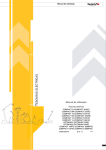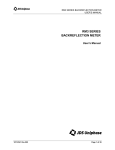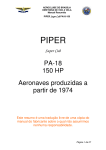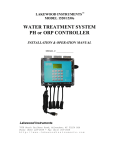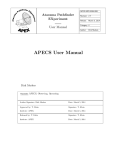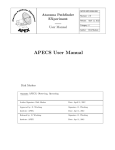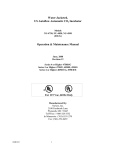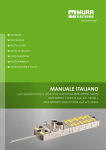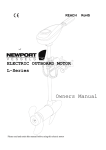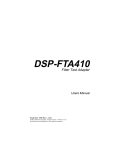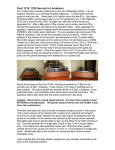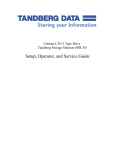Download Artisan Technology Group is your source for quality new and
Transcript
Artisan Technology Group is your source for quality new and certified-used/pre-owned equipment • FAST SHIPPING AND DELIVERY • TENS OF THOUSANDS OF IN-STOCK ITEMS • EQUIPMENT DEMOS • HUNDREDS OF MANUFACTURERS SUPPORTED • LEASING/MONTHLY RENTALS • ITAR CERTIFIED SECURE ASSET SOLUTIONS SERVICE CENTER REPAIRS Experienced engineers and technicians on staff at our full-service, in-house repair center WE BUY USED EQUIPMENT Sell your excess, underutilized, and idle used equipment We also offer credit for buy-backs and trade-ins www.artisantg.com/WeBuyEquipment InstraView REMOTE INSPECTION LOOKING FOR MORE INFORMATION? Visit us on the web at www.artisantg.com for more information on price quotations, drivers, technical specifications, manuals, and documentation SM Remotely inspect equipment before purchasing with our interactive website at www.instraview.com Contact us: (888) 88-SOURCE | [email protected] | www.artisantg.com TB9 SERIES OPTICAL GRATING FILTER User’s Manual Artisan Technology Group - Quality Instrumentation ... Guaranteed | (888) 88-SOURCE | www.artisantg.com Artisan Technology Group - Quality Instrumentation ... Guaranteed | (888) 88-SOURCE | www.artisantg.com Contents Safety Information, Instructions, and Symbols.......................................................................1 Safety Information ...........................................................................................................1 Classification .......................................................................................................1 Disconnecting from Line Power ...........................................................................1 Line Power Requirements ...................................................................................1 Fuse Type............................................................................................................1 Safety Instructions...........................................................................................................2 Before Initializing and Operating the Unit ............................................................2 Operating the Unit ...............................................................................................2 Safety Symbols ...............................................................................................................4 Compliance .....................................................................................................................5 CE Compliance....................................................................................................5 UL Compliance ....................................................................................................5 General Information and Specifications ..................................................................................6 General Information ........................................................................................................6 Optics .................................................................................................................6 Key Features .......................................................................................................7 Applications .........................................................................................................7 Standard Accessories..........................................................................................7 Specifications ..................................................................................................................7 Getting Started ..........................................................................................................................9 Before Initializing and Operating the Unit........................................................................9 Initial Inspection...............................................................................................................9 Operating Environment .................................................................................................10 Temperature ......................................................................................................10 Humidity.............................................................................................................10 Ventilation..........................................................................................................10 Storing and Shipping.....................................................................................................10 Claims and Repackaging...................................................................................10 Returning Shipments to JDS Uniphase .............................................................10 Cleaning Connectors.....................................................................................................11 Cleaning the UCA Bulkheads........................................................................................13 Powering and Warming up the Grating Filter ................................................................14 Operating and Maintenance Instructions ..............................................................................16 Front Panel....................................................................................................................16 Connector Panel................................................................................................17 Rear Panel ....................................................................................................................17 Setting the Wavelength.................................................................................................17 Activating the 5 V Output ..............................................................................................17 Setting the GPIB Address .............................................................................................18 Calibrating the Grating Filter .........................................................................................18 Maintaining the Grating Filter ........................................................................................18 SD000290 Rev. 500 April 2001 Artisan Technology Group - Quality Instrumentation ... Guaranteed | (888) 88-SOURCE | www.artisantg.com Programming Guide................................................................................................................19 GPIB Interface...............................................................................................................19 GPIB Interface Pin Assignment and Functions..................................................19 RS232 Interface ............................................................................................................20 RS232 Pin Assignment and Functions ..............................................................20 RS232 Driver Pin Assignment .......................................................................................20 Connecting the PC Serial Port to the TB9 Grating Filter ...............................................21 Operation and Query Commands .................................................................................22 Command Parser Rules.....................................................................................22 Operation Commands........................................................................................22 Query Commands..............................................................................................23 Status Reporting and Service Request Control.............................................................24 Status Register ..................................................................................................25 SRQ Mask Register ...........................................................................................25 GPIB Programming Examples.......................................................................................26 Sending Commands ..........................................................................................26 Querying Status.................................................................................................26 Serial Polling the Status Register ......................................................................27 Generating a Service Request Interrupt ............................................................27 RS232 Interface Programming Example .......................................................................28 For sales and service information, contact JDS Uniphase or your local representative. JDS Uniphase Corporation 570 West Hunt Club Road Nepean, Ontario, Canada K2G 5W8 Phone: 613 727-1303 Fax: 613 727-8284 E-mail: [email protected] Website: http://www.jdsunph.com SD000290 Rev. 500 April 2001 Artisan Technology Group - Quality Instrumentation ... Guaranteed | (888) 88-SOURCE | www.artisantg.com Safety Information, Instructions, and Symbols Safety Information Classification The unit consists of an exposed metal chassis that is connected directly to earth via a power cord and, therefore, is classified as a Class 1 instrument. Class 1 refers to equipment relying on ground protection as a means of shock protection. The following symbol is used to indicate a protective conductor terminal in the unit. Disconnecting from Line Power Some of the circuits are powered whenever the unit is connected to the AC power source (line power). To ensure that the unit is not connected to the line power, disconnect the power cord from either the power inlet on the unit’s rear panel or from the AC line-power source (receptacle). The power cord must always be accessible from one of these points. If the unit is installed in a cabinet, the operator must be able to disconnect the unit from the line power by the system’s line-power filter. Line Power Requirements The unit can operate from any single-phase AC power source that supplies between 100 and 240 V at a frequency range of 50 to 60 Hz. The maximum power consumption is 80 VA. Fuse Type The fuse type used by the unit is 1 A, 250 V AC 5 X 20 mm. Safety – 1 Artisan Technology Group - Quality Instrumentation ... Guaranteed | (888) 88-SOURCE | www.artisantg.com Safety Instructions The following safety instructions must be observed whenever the unit is operated, serviced, or repaired. Failure to comply with any of these instructions or with any precaution or warning contained in the user’s manual is in direct violation of the standards of design, manufacture, and intended use of the unit. JDS Uniphase assumes no liability for the customer’s failure to comply with any of these safety requirements. Before Initializing and Operating the Unit Inspect the unit for any signs of damage, and read the user’s manual thoroughly. Install the unit as specified in the Getting Started section. Ensure that the unit and any devices or cords connected to it are properly grounded. Operating the Unit Warning To avoid the risk of injury or death, always observe the following precautions before initializing the unit: • If using a voltage-reducing autotransformer to power the unit, ensure that the common terminal connects to the earthed pole of the power source. • Use only the type of power cord supplied with the unit. • Connect the power cord only to a power outlet equipped with a protective earth contact. Never connect to an extension cord that is not equipped with this feature. • Do not interrupt the protective earth grounding. Any such action can lead to a potential shock hazard that can result in serious personal injury. If an interruption to the protective grounding is suspected, ensure that the unit remains inoperative • Never look into the end of an optical cable connected to an optical output device that is operating. Laser radiation is invisible, and direct exposure can severely injure the human eye. Depending on input power, output power of TB9P can emit “class IV” laser light. For more information, see the user’s manual of the laser source in use. • Dirty fiber connector can be damaged under high power input. make sure fiber connector is cleaned properly. • Turning off the power to the device does not always block the externally supplied radiation to the connector at the output of the unit. • Do not use the unit outdoors. • To prevent potential fire or shock hazard, do not expose the unit to any source of excessive moisture. • Do not operate the unit when its covers or panels have been removed. Always Safety – 2 Artisan Technology Group - Quality Instrumentation ... Guaranteed | (888) 88-SOURCE | www.artisantg.com • Use only the type of fuse specified by the manufacturer as appropriate for this unit. Do not use repaired fuses, and avoid any situations that can shortcircuit the fuse. • Unless absolutely necessary, do not attempt to adjust or perform any maintenance or repair procedure when the unit is opened and connected to a power source. • Repairs are to be carried out only by a qualified professional. • Do not attempt any adjustment, maintenance, or repair procedure to the unit’s internal mechanism if immediate first aid is not accessible. • Disconnect the power cord from the unit before adding or removing any components. • Operating the unit in the presence of flammable gases or fumes is extremely hazardous. • Do not perform any operating or maintenance procedure that is not described in the user’s manual. • Some of the unit’s capacitors can be charged even when the unit is not connected to the power source. Safety – 3 Artisan Technology Group - Quality Instrumentation ... Guaranteed | (888) 88-SOURCE | www.artisantg.com Safety Symbols The following symbols and messages can be marked on the unit (Table 1). Observe all safety instructions that are associated with a symbol. Table 1: Safety Symbols Symbol Description Laser safety. See the user’s manual for instructions on handling and operating the unit safely. See the user’s manual for instructions on handling and operating the unit safely. Electrostatic discharge (ESD). See the user’s manual for instructions on handling and operating the unit safely. Frame or chassis terminal for electrical grounding within the unit. Protective conductor terminal for electrical grounding to the earth. WARNING The procedure can result in serious injury or loss of life if not carried out in proper compliance with all safety instructions. Ensure that all conditions necessary for safe handling and operation are met before proceeding. CAUTION The procedure can result in serious damage to or destruction of the unit if not carried out in compliance with all instructions for proper use. Ensure that all conditions necessary for safe handling and operation are met before proceeding. Safety – 4 Artisan Technology Group - Quality Instrumentation ... Guaranteed | (888) 88-SOURCE | www.artisantg.com Compliance CE Compliance The unit has been designed and tested to comply with directive 73/23/EEC and its subsequent amendments by the European Community (EC or CE). The directive relates to electrical equipment designed for use within certain voltage limits. It ensures that electrical equipment is constructed with good engineering practice in safety matters. The unit has been designed and tested to comply with directive 89/336/EEC and its subsequent amendments. The directive relates to electromagnetic compatibility. It demands that electromagnetic disturbance does not exceed a prescribed level; that the equipment be immune to a prescribed level of ambient interference; that the equipment be protected against electrostatic discharges; and that the equipment be immune to all electrical shock wave disturbances. As of 1997, measures have been added to test for fire hazard, electric shock hazard, and also external exposure to other forms of energy. The requirements specified by directive 89/336/EEC are as follows. CE compliance requires that the manufacturer or its authorized representative established within the Community affix the EC conformity mark to the apparatus or else to the packaging, instructions for use, or guarantee certificate. The EC conformity mark shall consist of the letters CE as specified and the figures of the year in which the mark was affixed. This mark should, where appropriate, be accompanied by the distinctive letters used by the notified body issuing the EC typeexamination certificate. Where the apparatus is the subject of other Directives providing for the EC conformity mark, the affixing of the EC mark shall also indicate conformity with the relevant requirements of those other Directives. UL1 Compliance The unit complies with Underwriters Laboratories (UL) standard 1950, the Standard for Safety Information Technology Equipment. The unit complies with Underwriters Laboratories (UL) standard 3101.1, Electrical Equipment for Laboratory Use; Part 1: General Requirements. 1 UL is a registered trademark of Underwriters Laboratories Inc. Safety – 5 Artisan Technology Group - Quality Instrumentation ... Guaranteed | (888) 88-SOURCE | www.artisantg.com General Information and Specifications General Information This user’s manual for the TB9 Series Optical Grating Filter contains complete operating instructions. The TB9 grating filter is designed for high performance laboratory and production testing of single-mode fiber-based components and subsystems (Figure 1). Single- and double-pass grating configurations are available to provide high rejection and narrow bandwidth. Optical performance for the C-band is optimized in the 1530 to 1570 nm window, but the filter can be controlled over the wavelength range of 1460 to 1575 nm. Optical performance for the L-band is optimized in the wavelength range of 1525 to 1625 and has a tuning range of 1460 to 1575. Six standard models are available with different bandwidths and optical performance. Figure 1: TB9 Optical Grating Filter The TB9 grating filter contains a lens that collimates light from the input fiber. A diffraction grating reflects collimated light back through the lens. This filtered light is then focused into the output fiber. The angle of the diffraction grating is controlled by a stepper motor that is driven by the microprocessor of the TB9 grating filter. On power-up, the microprocessor positions the angle of the grating to 1460 nm or to 1525 nm for extended-range models. Each time a wavelength command is entered, the microprocessor determines how many steps this wavelength is from the reference position and moves the diffraction grating to the required angle. Optics The optics of the TB9 grating filter are bi-directional, and therefore either fiber port can be used as the input. If an optional coupler or switch is installed, the user must ensure that the connections to these are appropriate. Getting Started – 6 Artisan Technology Group - Quality Instrumentation ... Guaranteed | (888) 88-SOURCE | www.artisantg.com Key Features • • • • • Grating-based optical filter Full width at half maximum (FWHM) as low as 0.22 nm High rejection Single-mode fiber in and out GPIB parallel interface and RS232 serial interface Applications • • • • Spontaneous emission suppression Tunable laser-based testing Erbium doped fiber amplifier (EDFA) testing Wavelength division multiplexer (WDM) and dense WDM (DWDM) component testing Standard Accessories • • • AC power cord Rack-mount kit with assembly instructions User’s manual Specifications The following optical specifications describe the warranted characteristics of the TB9 (Table 2). Supplementary specifications describe the typical non-warranted performance of the unit (Table 3). Table 2: Optical Specifications Parameter TB9226 TB9166 TB9223 TB9126 TB9116 TB9106 Tuning Range 14601575 or 15251625 14601575 14601575 or 15251625 14601575 14601575 14601575 -3 dB bandwidth (±15%) 0.22 nm 0.25 nm 0.55 nm 0.55 nm 1.1 nm 1.4 nm -20 dB bandwidth (±15%) 0.6 nm 0.7 nm 1.5 nm 1.5 nm 3.0 nm 4.0 nm Insertion loss 1530-1570 1525-1625 ≤6.0 dB ≤7.0 dB ≤4.0 dB ≤5.5 dB ≤7.0 dB ≤3.0 dB ≤3.0 dB ≤3.0 dB PDL 1530-1570 1525-1625 ≤0.2 dB ≤0.5 dB ≤0.6 dB ≤0.2 dB ≤0.5 dB ≤0.6 dB ≤0.6 dB ≤0.6 dB Input Power Standard High Power 300 mW 1W 300 mW 1W 300 mW 1W 300 mW 1W 300 mW 1W 300 mW 1W Resolution 0.01 nm Return loss >45 dB Getting Started – 7 Artisan Technology Group - Quality Instrumentation ... Guaranteed | (888) 88-SOURCE | www.artisantg.com Repeatability 0.05 nm Accuracy 0.2 nm Table 3: Other specifications Electrical Input voltage 100 to 240 V AC, 50 to 60 Hz Power consumption 80 VA maximum Physical Weight 4 kg Dimensions (W x H x D) 19 in (48.26 cm) rackmount 21.2 x 8.9 x 35.5 cm 2U high, ½ rack width Environmental Storage temperature 0 to 50 °C Operating temperature 10 to 40 °C Humidity maximum 95% RH up to 40 °C, decreasing at 5% per °C from 40 to 50 °C Getting Started – 8 Artisan Technology Group - Quality Instrumentation ... Guaranteed | (888) 88-SOURCE | www.artisantg.com Getting Started The TB9 Series Optical Grating Filter consists of the filter unit, an AC power cord, a user's manual, the test report and a warranty card. Before Initializing and Operating the Unit Inspect the unit for any signs of damage. Read the user’s manual thoroughly, and become familiar with all safety symbols and instructions to ensure that the unit is operated and maintained safely. Initial Inspection Warning To avoid electrical shock, do not initialize or operate the unit if it bears any sign of damage to any portion of its exterior surface, such as the outer cover or panels. Check that the unit and contents are complete: 1. Wear an anti-static wrist strap, and work in an electrostatic discharge (ESD) controlled area. 2. Inspect the shipping container for any indication of excessive shock to the contents, and inspect the contents to ensure that the shipment is complete. 3. Inspect the unit for structural damage that can have occurred during shipping. 4. Connect the unit to a power source, using the AC power cord provided. 5. Set the power switch to I (on) and observe the power-up sequence. The key lamps and status LEDs will illuminate. The version of the software is displayed briefly followed by “TB9(CRLF) AD”. CRLF is the message terminating sequence <CR> <LF>, AD is the GPIB address (a number between 1 and 32). After the power-up sequence is complete the instrument will display the wavelength that corresponds with start of the tuning range (1460 or 1525 depending on the model). If a malfunction is detected during power-up, an error message is displayed. 6. Allow the instrument to stabilize for two hours before use. 7. Keep the packaging. Immediately inform JDS Uniphase and, if necessary, the carrier if the contents of the shipment are incomplete, if the unit or any of its components are damaged or defective, or if the unit does not pass the initial inspection. Getting Started – 9 Artisan Technology Group - Quality Instrumentation ... Guaranteed | (888) 88-SOURCE | www.artisantg.com Operating Environment In order for the unit to meet the warranted specifications, the operating environment must meet the following conditions for temperature, humidity, and ventilation. Temperature The unit can be operated in the temperature range of 10 to 40 °C. Humidity The unit can be operated in environments with up to 95% relative humidity (up to 40 °C), decreasing 5% per °C from 40 to 50 °C. Do not expose it to any environmental conditions or changes to environmental conditions that can cause condensation to form inside the unit. Ventilation The unit contains a built-in cooling fan. Do not install it in any location where the ventilation is blocked. For optimum performance, the unit must be operated from a location that provides at least 75 mm (3 inches) of clearance at the rear and at least 25 mm (1 inch) of clearance at the bottom. Blocking the air circulation around the unit can cause the unit to overheat, compromising its reliability. Warning • Do not use the unit outdoors. • To prevent potential fire or shock hazard, do not expose the unit to any source of excessive moisture. Storing and Shipping To maintain optimum operating reliability, do not store the unit in locations where the temperature falls below 0 °C or rises above 50 °C. Avoid any environmental condition that can result in internal condensation. Ensure that these temperature and humidity requirements can also be met whenever the unit is shipped. Claims and Repackaging Immediately inform JDS Uniphase and, if necessary, the carrier, if • • • The contents of the shipment are incomplete The unit or any of its components are damaged or defective The unit does not pass the initial inspection In the event of carrier responsibility, JDS Uniphase will allow for the repair or replacement of the unit while a claim against the carrier is being processed. Returning Shipments to JDS Uniphase JDS Uniphase only accepts returns for which an approved Return Material Authorization (RMA) has been issued by JDS Uniphase sales personnel. This number must be obtained prior to shipping any material to JDS Uniphase. The owner’s name and address, the model number Getting Started – 10 Artisan Technology Group - Quality Instrumentation ... Guaranteed | (888) 88-SOURCE | www.artisantg.com and full serial number of the unit, the RMA number, and an itemized statement of claimed defects must be included with the return material. Ship return material in the original shipping container and packing material. If these are not available, packaging guidelines are as follows: 1. Cover the front panel with a strip of anti-static foam. 2. Wrap the unit in anti-static packaging. Use anti-static connector covers. 3. Pack the unit in a reliable shipping container. 4. Use enough shock-absorbing material (10 to 15 cm or 4 to 6 in on all sides) to cushion the unit and prevent it from moving inside the container. Pink poly anti-static foam is the best material. 5. Seal the shipping container securely. 6. Clearly mark FRAGILE on its surface. 7. Always provide the model and serial number of the unit and, if necessary, the RMA number on any accompanying documentation. 8. Please contact the RMA department using the contact information at the beginning of this document to obtain an RMA number and a shipping address. Cleaning Connectors Caution • Connecting damaged or dirty connectors to the unit can damage the connectors on the unit. • Dirty connectors can be damaged when exposed to high power. • Never force an optical connector. Some connectors have a ceramic ferrule that can easily be broken. The following items are required for cleaning: • • • • 2 Filtered compressed air or dusting gas (for example, Tech Spray Envi-Ro-Tech Duster 1671 gas, available from http://www.techspray.com/1671.htm) Lint-free pipe cleaners (for example, from 3M2) or lint-free swab Lint-free towels (for example, 10 x 10 cm or 4 x 4 in HydroSorb III wipers, available from http://www.focenter.com/acctech/hydrosobr_wipers.htm) Optical grade isopropyl alcohol or optical grade 200° ethanol (do not use rubbing alcohol, which contains 30% water) 3M is a trademark of 3M. Getting Started – 11 Artisan Technology Group - Quality Instrumentation ... Guaranteed | (888) 88-SOURCE | www.artisantg.com • No. 0 Phillips screwdriver Cleaning the jumper connector: Figure 2: Typical jumper connector 1. Apply alcohol to a small area of a lint-free towel and rub the end of the ferrule over the wet area. 2. Wipe the ferrule on a dry area of the lint-free towel. 3. Using the dusting gas or compressed air, blow the end of the ferrule. 4. Apply the alcohol or ethanol to a lint-free pipe cleaner or swab and wipe off the remaining parts of the connector. 5. With the other end of the pipe cleaner or swab, dry the areas cleaned. 6. Using the dusting gas or compressed air, blow the areas cleaned. Cleaning the mating sleeve: 1. Blow compressed air inside the opening of the mating sleeve to remove trapped particles (Figure 3). 2. Moisten a fresh pipe cleaner with alcohol. Gently clean the opening by inserting the pipe cleaner using a rotating motion. 3. Blow compressed air inside the opening to remove any remaining material. Getting Started – 12 Artisan Technology Group - Quality Instrumentation ... Guaranteed | (888) 88-SOURCE | www.artisantg.com Figure 3: Typical Mating Sleeve Cleaning the UCA Bulkheads Cleaning Procedure: The TB9’s are manufactured with protective covers to shield users from the potentially harmful signal that could be emitted from the optical ports. The covers are designed to provide sufficient clearance for maintenance, cleaning, and for changing or replacing adapters. Before cleaning it is recommended that all jumpers be disconnected, as the TB9 can transmit signal even when the power is turned off. To avoid injury, do not reconnect jumpers until all ports have been cleaned. 1. Remove the two adapter mounting screws with the No. 0 Phillips screwdriver (see Figure 4). Removing the adapter will expose the internal connector that is fastened to the base plate. The internal connectors are mounted at the factory and should not have to be adjusted under normal operating conditions. 2. Apply alcohol to a small area of a lint-free towel and gently rub the connector end to clean. Do not to apply excessive pressure while rubbing, to avoid scratching and pitting. Discard tissues after a single use to avoid contamination. 3. Gently wipe flat surface of the base plate to ensure a clear mating surface during reassembly. Getting Started – 13 Artisan Technology Group - Quality Instrumentation ... Guaranteed | (888) 88-SOURCE | www.artisantg.com Figure 4: Universal Connector Adapter 4. Clean the internal cavity with a pipe cleaner and alcohol (a rotating motion will yield the best results). The adapter is a critical component that can provide highly reliable mating of optical connector, if properly maintained. 5. Gently wipe the flat surface of the adapter to ensure a clear mating surface during reassembly. 6. To insert the adapter sleeve into the base plate, align the center axis of the two parts and make sure the alignment key will mate with the alignment hole on the flat surface of the base plate. Once in position, fasten the two adapter mounting screws to secure the parts together. 7. Clean all ports by repeating Steps 1 - 4. 8. All jumper connectors used to mate other equipment with the TB9 should be cleaned thoroughly (see connector cleaning section). Powering and Warming up the Grating Filter To power up the TB9 grating filter: 1. Connect the TB9 grating filter to the AC power source, using the AC power cord provided. 2. Set the power switch to I (on) and observe the power-up sequence. The key lamps and status LEDs will illuminate. The version of the software is displayed briefly followed by “TB9(CRLF) AD”. CRLF is the message terminating sequence <CR> <LF>, AD is the GPIB address (a number between 1 and 32). After the power-up sequence is complete the instrument will display the wavelength that corresponds with the start of the tuning range Getting Started – 14 Artisan Technology Group - Quality Instrumentation ... Guaranteed | (888) 88-SOURCE | www.artisantg.com (1460 or 1525 depending on the model). If a malfunction is detected during power-up, an error message is displayed. 3. Allow the instrument to stabilize for two hours before use. An electrical current is supplied continuously to the heater elements of the TB9 grating filter until its internal temperature reaches the set point. Getting Started – 15 Artisan Technology Group - Quality Instrumentation ... Guaranteed | (888) 88-SOURCE | www.artisantg.com Operating and Maintenance Instructions Front Panel The front of the filter is shown in Figure 5 and described in Table 4 and Table 5. TB9 grating filters with a built-in splitter or switch have three fiberoptic connectors. 5V TB9 OPTICAL GRATING FILTER LCL I REM LOCK ADDR SRQ Figure 5: Front of Filter Table 4: Operating Keys Key Description I/O Power on (I) /off (O) switch. 5V Controls the on/off state of the driver. LCL Returns the unit to Local mode from Remote mode, and sets the GPIB address. ▲/▼ ▲) or down (▼) through operation settings, such as wavelength and GPIB Scroll up ( address. Each pair controls a digit in the corresponding position displayed on the LCD. Table 5: Status LEDs LED Description REM Indicates that the unit is in Remote mode. All the front-panel keys except LCL are locked out. LOCK Indicates that the unit is in Local Lockout mode. The function of the LCL key is disabled, and all front-panel keys are locked out. ADDR Indicates that the GPIB interface is in talk or listen state. Operating and Maintenance Instructions – 16 Artisan Technology Group - Quality Instrumentation ... Guaranteed | (888) 88-SOURCE | www.artisantg.com LED SRQ Description Indicates that the unit interrupt logic has generated a service request interrupt (SRQ) on the GPIB interface. Connector Panel Two fiberoptic connectors, or cable feed-throughs, are mounted on a removable panel. On TB9P there are two universal connector laser safety covers in the same place as the connectors on the standard TB9. Rear Panel The back of the filter is shown in Figure 6. WARNING: FOR CONTINUED FIRE PROTECTION USE SPECIFIED ~LINE FUSE ONLY. DISCONNECT POWER CORD BEFORE REPLACING FUSE. TO AVOID ELECTRICAL SHOCK THE POWERCORD PROTECTIVE GROUNDING CONDUCTOR MUST BE CONNECTED TO GROUND. RS232C IEEE488(GPIB) MEASURING EQUIPMENT 82NJ ~LINE 50-60 Hz 100-240 V 80 VA max FUSE T1A/250V NO OPERATOR SERVICEABLE PARTS INSIDE. WARNING REFER SERVICE TO SERVICE TRAINED PERSONNEL. Figure 6: Back of Filter Setting the Wavelength Standard TB9 models cannot be set to a wavelength below 1460 nm or above 1575 nm. Extended-range TB9 models cannot be set to a wavelength below 1525 nm or above 1625 nm. To set the wavelength of the TB9 grating filter: 1. Press the ▲ or ▼ keys to scroll to the required wavelength setting. Activating the 5 V Output The 5 V output function is available to act as an external relay driver. Operating and Maintenance Instructions – 17 Artisan Technology Group - Quality Instrumentation ... Guaranteed | (888) 88-SOURCE | www.artisantg.com To use the 5 V output: 1. Activate the external relay driver by pressing the 5V key so that the key lamp lights. 2. Deactivate the external relay driver by pressing the 5V key so that the key lamp turns off. Setting the GPIB Address The TB9 filter can be controlled from the front panel keypad, or remotely by GPIB or RS232C interface. If you intend to use the GPIB interface, you must set the GPIB address before operating the TB9 grating filter in Remote mode: 1. Ensure that the TB9 grating filter is powered off. 2. Set the power switch to I (on), and press and hold the LCL key as the TB9 grating filter powers up. 3. The message “TB9(CRLF) AD” is displayed, where CRLF is the message terminating sequence <CR> <LF>, and AD (a number between 1 and 32) is the GPIB address. 4. Press the last pair of ▲ / ▼ keys to scroll to the required GPIB address. 5. To store the address in nonvolatile memory, press the LCL key. The TB9 grating filter always powers-up with the last GPIB address setting used. The message terminating sequence is permanently set to <CR> <LF>. Calibrating the Grating Filter Calibration for the unit is factory-set. To ensure reliable performance, yearly recalibration is recommended. Return the unit to JDS Uniphase for recalibration. Maintaining the Grating Filter Clean the connector ends before every mating to increase the operating life of the connectors, minimize insertion loss, and reduce backreflection. Please refer to the Cleaning Connectors section. Depending on the TB9 model and the option chosen the instrument will have either two or three connectors on the front. Each connector should be cleaned thoroughly before use. Operating and Maintenance Instructions – 18 Artisan Technology Group - Quality Instrumentation ... Guaranteed | (888) 88-SOURCE | www.artisantg.com Programming Guide The following programming instructions for the TB9 grating filter are intended for users who are familiar with remote interfaces and how to send or receive messages over a device. A detailed description of the GPIB interface is in ANSI/IEEE Std. 488.1-1987 IEEE Standard Digital Interface for Programmable Instrumentation published by the Institute of Electrical and Electronics Engineers. There are two external interfaces for remote control of the TB9 filter: a GPIB parallel interface and an RS232 serial interface. The TB9 grating filter accepts the same device dependent commands—the commands that control the instrument—over either interface. GPIB Interface GPIB Interface Pin Assignment and Functions The required GPIB pin assignment is shown in Figure 7 and the functions are listed in Table 6. Figure 7: GPIB Pin Assignment Table 6: GPIB Functions Mnemonic IEEE 488.1 Function SH1 source handshake, complete capability AH1 acceptor handshake, complete capability T6 basic talker, serial poll, unaddressed if MLA L4 basic listener, unaddressed if MTA SR1 service request capability (table continued) Operating and Maintenance Instructions – 19 Artisan Technology Group - Quality Instrumentation ... Guaranteed | (888) 88-SOURCE | www.artisantg.com Mnemonic IEEE 488.1 Function RL1 remote/local, complete capability PP0 parallel poll, no capability DC1 device clear, complete capability DT0 device trigger, no capability C0 controller, no capability E1 electrical interface, open collector drivers RS232 Interface RS232 Pin Assignment and Functions The RS232 pin assignment is shown in Figure 8 and the interface functions are listed in Table 7. Figure 8: RS232 Pin Assignment Table 7: RS232 Functions Name Symbol Pin Number Signal Direction transmitted data TxD 2 out received data RxD 3 in request to send RTS 8 out clear to send CTS 7 in data terminal ready DTR 6 out signal ground SG 5 The data protocol is permanently set to 1200 baud, ASCII character code with eight bits per character, one stop bit, and no parity bit. The serial port of the controlling computer must be configured with the same settings. Use a straight-through cable to connect the TB9 grating filter to the serial port of a DTE (computer). RS232 Driver Pin Assignment The RS232 driver pin assignment is shown in Figure 9. Operating and Maintenance Instructions – 20 Artisan Technology Group - Quality Instrumentation ... Guaranteed | (888) 88-SOURCE | www.artisantg.com Figure 9: RS232 Driver Pin Assignment Caution • Do not exceed 100 mA. Connecting the PC Serial Port to the TB9 Grating Filter To connect a 25-pin PC serial port to the grating filter, use 25-pin D-sub plug connectors at both ends of the connection. The required pin assignment is described in Table 8. Table 8: Connecting a 25-Pin PC Serial Port to the TB9 Grating Filter PC 25-Pin TB9 Unit Symbol Pin Number Pin Number Symbol PG 1 1 PG TD 2 3 RD RD 3 2 TD RTS 4 5 CTS CTS 5 4 RTS SG 7 7 SG To connect a 9-pin PC serial port to the grating filter, use a 9-pin D-sub plug connector at the computer and a 25-pin D-sub plug connectors at the filter. The required pin assignment is described Table 9. Table 9: Connecting a 9-Pin PC Serial Port to the TB9 Grating Filter PC 9-Pin TB9 Unit Symbol Pin Number Pin Number Symbol PG 1 1 PG TD 3 3 RD RD 2 2 TD RTS 7 5 CTS CTS 8 4 RTS SG 5 7 SG Operating and Maintenance Instructions – 21 Artisan Technology Group - Quality Instrumentation ... Guaranteed | (888) 88-SOURCE | www.artisantg.com Operation and Query Commands Operation and query commands control instrument functions and are interface-independent. Command Parser Rules • A command consists of a mnemonic (for example, CLOSE) and, if required, a data parameter. The mnemonic and the data parameter must be separated by at least one space. • Parameters can be entered in various formats; for example, 10, 10.0, and 1.0e1 are recognized as the same value. • Commands can be sent in uppercase or lowercase characters. • A command is contained in a message, and messages can contain more than one command, each one separated by a semicolon (;). For example, CLOSE 6;XDR 2 1 <CR> <LF> contains two commands. • All GPIB commands must end with the terminating sequence <CR> <LF>. • All RS232 commands must be terminated with a single <CR> character. • The input buffer of the filter can hold as many as 100 characters. If the buffer becomes full, the filter holds the handshaking line on the GPIB interface until space is available. Similarly, over the RS232 interface, the filter sets the Clear-To-Send line low. Any characters received after the line goes low are ignored. • Commands are executed as they are parsed; consequently, a command can be executed before the entire message in which it is contained is received. • The switch delays accepting new characters sent over the GPIB interface while the filter mechanism is moving, but no data are lost. The filter is always ready to accept characters over the RS232 interface. • A query command is used to extract status information from the filter. For example, SRE? <CR> <LF> returns the contents of the status register. • Multiple-command messages can contain only one query command. A query must be the last command in the message, for example, CLOSE 20; XDRS? <CR> <LF>. Operation Commands XDR External Relay Driver Control Sets the external driver on or off: • • 0 = relay driver off 1 = relay driver on Operating and Maintenance Instructions – 22 Artisan Technology Group - Quality Instrumentation ... Guaranteed | (888) 88-SOURCE | www.artisantg.com WVL Wavelength Control Sets the wavelength of the TB9 filter; the default unit is in meters (M): • • • • M = meters MM = millimeters UM = micrometers NM = nanometers SRE i SQR Mask Writes a decimal number to the SRQ mask register (see the Status Reporting and Service Request Control section). Setting a bit to 1 generates an SRQ interrupt when the corresponding bit in the status register changes from 0 to 1. CSB Clear Status Byte Resets the status byte. CLR Clear Device Clears the SRQ mask register and the status register. Query Commands XDR? i Driver Returns the state of an external relay driver (i): • • 0 = relay driver off 1 = relay driver on WVL? Wavelength Returns the wavelength setting: • • • WVL? returns the current wavelength setting WVL? MIN returns the minimum wavelength compensation range WVL? MAX returns the maximum wavelength compensation range STB? Status Register Returns a three-digit integer and automatically clears the status register if the SRQ bit is set. Operating and Maintenance Instructions – 23 Artisan Technology Group - Quality Instrumentation ... Guaranteed | (888) 88-SOURCE | www.artisantg.com SRE? SRQ Mask Returns the contents of the SRQ mask register. CNB? Condition Register Returns the contents of the condition register. TST? Self-Test Executes a self-test operation. An error code that can be queried with ERR? or LERR? is placed in an error queue. The query TST? also sets bit 7 in the status register. • • 0 = self-test passed 1 = self-test failed ERR? Error Number Returns an error number if the self-test fails: • • 330 = self-test failed 0 = self-test did not fail LERR? Last Number Error Returns a three-digit error number from the error queue. The queue can contain as many as five error numbers. The first error read is the last error that occurred. LERR? returns 000 if the error queue is empty. OPC? Operation Complete Returns the status of the input buffer: • • 1 = the input buffer is empty, for example, all commands have been executed 0 = the input buffer is not empty, for example, commands are still pending IDN? Identifier Returns a string that identifies the manufacturer, the TB9 filter series, the serial number (or 0 if unavailable), and the firmware level, for example, JDS Uniphase, TB9, 0, 0. Status Reporting and Service Request Control The TB9 grating filter maintains two eight-bit registers that are used for status reporting and enabling the GPIB service request interrupt: • Status register Operating and Maintenance Instructions – 24 Artisan Technology Group - Quality Instrumentation ... Guaranteed | (888) 88-SOURCE | www.artisantg.com • SRQ mask register Status Register The status register records errors and other events that have occurred in the filter (Table 10). When an event occurs, the filter status logic sets the corresponding bit to 1. The status register can be read at any time because the bits stay set until the register is read at least once. Table 10: Status Register Status Register Bit 7 Bit 6 Bit 5 Bit 4 Bit 3 Bit 2 Bit 1 Bit 0 self-test error service request syntax error message available 0 settled 0 parameter error • Bit 7 (self-test error) is set if a calibration error is detected after power-up or after the self-test query (TST?) is executed. At all other times it is 0. • Bit 6 (service request) is set when the interrupt request logic of the filter detects a reason to generate a service request interrupt on the GPIB interface. • Bit 5 (syntax error) is set when the parser detects a syntax error in a command mnemonic. • Bit 4 (message available) is set when a message is available in the output buffer. • Bit 2 (settled) is set when bit 2 in the condition register changes from 0 to 1. • Bit 0 (parameter error) is set when a parameter value is out of the range of the TB9 filter. The status register can be read with the status register query (STB?) or by serial polling the GPIB interface. During power-up, the status register contains 0 and can only be read by serial polling. After initial power-up, only the settled bit (bit 2) is set to 1. The clear status byte command (CSB) and the clear device command (CLR) clear the status register. STB? also clears the status register, but only if the service request bit (bit 6) is set to 1. SRQ Mask Register The SRQ mask register unmasks specific events in the status register that generate a service request interrupt on the GPIB interface (Table 11). The SRQ mask command (SRE) writes to the SRQ mask register. When a bit in the SRQ mask register is set to 1, the interrupt logic of the filter monitors the corresponding event bit in the status register. When a bit changes from 0 to 1, a service request interrupt is generated and bit 6 in the status register is set. Table 11: SRQ Mask Register SRQ Mask Register Bit 7 Bit 6 Bit 5 Bit 4 Bit 3 Bit 2 Bit 1 Bit 0 self-test error n/a syntax error message available n/a settled n/a parameter error Operating and Maintenance Instructions – 25 Artisan Technology Group - Quality Instrumentation ... Guaranteed | (888) 88-SOURCE | www.artisantg.com The SRQ mask register can unmask more than one event at a time. The first unmasked event to change from 0 to 1 causes an interrupt. To acknowledge this interrupt, the GPIB interface can be serial polled or the status register can be read with STB?. The first time the filter is serial polled after an SRQ is generated, bit 6 is on. Subsequent serial polling returns a value with bit 6 off. Similarly, STB? returns the status register with the SRQ set, but then the filter logic automatically clears the register. As a result, subsequent STB? queries return 0. The SRQ mask register is cleared by powering up the TB9 filter, by the clear device command (CLR), or by the universal device clear command ( DC1). GPIB Programming Examples This section provides programming examples for controlling the TB9 filter over the GPIB interface. The examples were written in MS-DOS Qbasic and run on a personal computer equipped with a National Instruments3 GPIB interface board with National Instruments Universal Language Interface drivers loaded. The commands that control the GPIB are similar to Hewlett Packard4 HP Basic commands. Most other controller board manufacturers provide basic output and input statements for communicating messages to a GPIB instrument. The GPIB commands that appear in this section do not always show the terminating sequence <CR> <LF>; however, it is implied. Sending Commands This example sets the wavelength to 1550 nm. OPEN "GPIB0" FOR OUTPUT AS #1 OPEN "GPIB0" FOR INPUT AS #2 PRINT #1, "ABORT" PRINT #1, "OUTPUT 05;wvl 1550e-9 m" END This example demonstrates the use of a variable in the statement that transmits the wavelength command. OPEN "GPIB0" FOR OUTPUT AS #1 OPEN "GPIB0" FOR INPUT AS #2 PRINT #1, "ABORT" xwvl = 1550 PRINT #1, "OUTPUT 05;wvl";xwvl;"nm" END Querying Status This sample queries and displays the current wavelength setting. OPEN "GPIB0" FOR OUTPUT AS #1 3 4 National Instruments is a trademark of National Instruments. Hewlett Packard is a registered trademark of Hewlett-Packard Co. Operating and Maintenance Instructions – 26 Artisan Technology Group - Quality Instrumentation ... Guaranteed | (888) 88-SOURCE | www.artisantg.com OPEN "GPIB0" FOR INPUT AS #2 PRINT #1, "ABORT" PRINT #1, "OUTPUT 05;WVL?" PRINT #1, "ENTER 05" INPUT #2, x PRINT x END Serial Polling the Status Register This sample changes the wavelength setting and reads the status register continuously until the output has settled. OPEN "GPIB0" FOR OUTPUT AS #1 OPEN "GPIB0" FOR INPUT AS #2 PRINT #1, "ABORT" PRINT #1, "OUTPUT 05;csb" bit PRINT #1, "OUTPUT 05;WVL 1530e-9m" sr = 0 WHILE (sr AND 4 ) PRINT #1, "SPOLL 05" INPUT #2, sr WEND PRINT sr END ' clearing the status byte clears the settling ' change the wavelength to 1530 nm ' initialize sr variable to enter the while loop ' loop until settled bit is true ' serial poll the TB9 filter ' print final value of sr Generating a Service Request Interrupt This example tests the service request interrupt function. It unmasks the settling bit in the SRQ mask register and sends a new wavelength setting. An interrupt is generated when the TB9 grating filter has completed changing the wavelength. OPEN "GPIB0" FOR OUTPUT AS #1 OPEN "GPIB0" FOR INPUT AS #2 PRINT #1, "ABORT" ON PEN GOSUB SPOLL PEN ON PRINT #1, "OUTPUT 05;CSB;SRE 4" ' enable SRQ interrupt ' clear status register and unmask ' settled bit in SRQ mask register PRINT #1 "OUTPUT 05;WVL 1552.02nm" ' change wavelength setting ' ' mode executed while wavelength set ' ' WHILE (INKEY$ = "") ' endless loop to simulate bigger program WEND ' ends when any key is pressed PEN OFF END SPOLL: PRINT #1, "SPOLL 05" ' serial poll the TB9 filter Operating and Maintenance Instructions – 27 Artisan Technology Group - Quality Instrumentation ... Guaranteed | (888) 88-SOURCE | www.artisantg.com INPUT #2, sr PRINT sr PRINT #1, "SPOLL 05" INPUT #2, sr PRINT sr RETURN ' read status register ' verify SRQ bit is set ' serial poll again to verify SRQ bit is cleared ' read status register RS232 Interface Programming Example This section provides a programming example for controlling the TB9 grating filter over the RS232 interface. The sample was written in MS-DOS Qbasic and run on a personal computer, equipped with a serial port. The COM 2 port of the computer must be designated as the serial port and must be connected to the TB9 grating filter. The RS232 command that appears in this section does not show the terminating character <CR>; however, it is implied. The RS232C interface cannot receive an SRQ interrupt. OPEN "com2:1200,n,8,1" FOR RANDOM AS #1 CLS ' clear unit PRINT #1, "clr" ' identify unit PRINT #1, "idn?" INPUT #1 PRINT a$ ' set unit to 1550 nm PRINT #1, "wvl 1550 nm" ' fetch status PRINT #1, "wvl?" INPUT #1, wvl PRINT #1, "xdr?" INPUT #1, xdr PRINT #1, "stb?" INPUT #1, stb PRINT #1, "sre?" INPUT #1, sre PRINT #1, "err?" INPUT #1, err PRINT #1, "lerr?" INPUT #1, lerr ' print status PRINT wvl,xdr,stb,sre,err,lerr CLOSE END Operating and Maintenance Instructions – 28 Artisan Technology Group - Quality Instrumentation ... Guaranteed | (888) 88-SOURCE | www.artisantg.com Artisan Technology Group is your source for quality new and certified-used/pre-owned equipment • FAST SHIPPING AND DELIVERY • TENS OF THOUSANDS OF IN-STOCK ITEMS • EQUIPMENT DEMOS • HUNDREDS OF MANUFACTURERS SUPPORTED • LEASING/MONTHLY RENTALS • ITAR CERTIFIED SECURE ASSET SOLUTIONS SERVICE CENTER REPAIRS Experienced engineers and technicians on staff at our full-service, in-house repair center WE BUY USED EQUIPMENT Sell your excess, underutilized, and idle used equipment We also offer credit for buy-backs and trade-ins www.artisantg.com/WeBuyEquipment InstraView REMOTE INSPECTION LOOKING FOR MORE INFORMATION? Visit us on the web at www.artisantg.com for more information on price quotations, drivers, technical specifications, manuals, and documentation SM Remotely inspect equipment before purchasing with our interactive website at www.instraview.com Contact us: (888) 88-SOURCE | [email protected] | www.artisantg.com






































